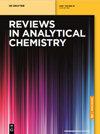Analysis of chemical warfare agents by gas chromatography-mass spectrometry: methods for their direct detection and derivatization approaches for the analysis of their degradation products
IF 3.8
3区 化学
Q2 CHEMISTRY, ANALYTICAL
引用次数: 54
Abstract
Abstract Chemical warfare agents (CWAs) are unarguably one of the most feared toxic substances produced by mankind. Their inception in conventional warfare can be traced as far back as the Middle Ages but their full breakthrough as central players in bellic conflicts was not realized until World War I. Since then, more modern CWAs along with efficient methods for their manufacture have emerged and violently shaped the way modern warfare and diplomatic relations are conducted. Owing to their mass destruction ability, counter methods to mitigate their impact appeared almost immediately on par with their development. These efforts have focused on their efficient destruction, development of medical countermeasures and their detection by modern analytical chemistry methods. The following review seeks to provide the reader with a broad introduction on their direct detection by gas chromatography-mass spectrometry (GC-MS) and the various sample derivatization methods available for the analysis of their degradation products. The review concentrates on three of the main CWA classes and includes the nerve agents, the blistering agents and lastly, the incapacitating agents. Each section begins with a brief introduction of the CWA along with discussions of reports dealing with their detection in the intact form by GC-MS. Furthermore, as products arising from their degradation carry as much importance as the agents themselves in the field of forensic analysis, the available derivatization methods of these species are presented for each CWA highlighting some examples from our lab in the Forensic Science Center at the Lawrence Livermore National Laboratory.气相色谱-质谱法分析化学战剂:直接检测方法及其降解产物的衍生化分析方法
化学战剂是人类生产的最可怕的有毒物质之一。它们在常规战争中的出现可以追溯到中世纪,但直到第一次世界大战才实现了它们在战争冲突中作为核心角色的全面突破。从那以后,更现代的CWAs及其有效的制造方法出现了,并猛烈地塑造了现代战争和外交关系的方式。由于它们具有大规模破坏的能力,减轻其影响的反方法几乎在它们发展的同时立即出现。这些努力的重点是有效销毁化学物质、发展医疗对策和用现代分析化学方法检测化学物质。下面的回顾旨在为读者提供一个广泛的介绍他们的直接检测气相色谱-质谱(GC-MS)和各种样品衍生化方法可用于分析其降解产物。综述集中在三种主要的化武类,包括神经毒剂,起泡剂和最后,失能剂。每一部分都以简短的CWA介绍开始,并讨论了用GC-MS完整形式检测CWA的报告。此外,由于其降解产生的产物在法医分析领域与试剂本身一样重要,因此本文为每个CWA介绍了这些物种的可用衍生化方法,并重点介绍了我们在劳伦斯利弗莫尔国家实验室法医科学中心的实验室的一些例子。
本文章由计算机程序翻译,如有差异,请以英文原文为准。
求助全文
约1分钟内获得全文
求助全文
来源期刊

Reviews in Analytical Chemistry
化学-分析化学
CiteScore
7.50
自引率
0.00%
发文量
15
审稿时长
>12 weeks
期刊介绍:
Reviews in Analytical Chemistry publishes authoritative reviews by leading experts in the dynamic field of chemical analysis. The subjects can encompass all branches of modern analytical chemistry such as spectroscopy, chromatography, mass spectrometry, electrochemistry and trace analysis and their applications to areas such as environmental control, pharmaceutical industry, automation and other relevant areas. Review articles bring the expert up to date in a concise manner and provide researchers an overview of new techniques and methods.
 求助内容:
求助内容: 应助结果提醒方式:
应助结果提醒方式:


